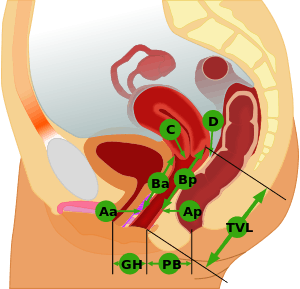Pelvic organ prolapse
| Pelvic organ prolapse | |
|---|---|
| Synonyms | Female genital prolapse |
| Classification and external resources | |
| Specialty | Gynecology |
| ICD-10 | N81 |
| ICD-9-CM | 618 |
| DiseasesDB | 25265 |
| MeSH | D014596 |
Pelvic organ prolapse (POP) is characterized by descent of pelvic organs from their normal positions. In women, the condition usually occurs when the pelvic floor collapses after gynecological cancer treatment, childbirth or heavy lifting.[1]
In men, it may occur after the prostate gland is removed. The injury occurs to fascia membranes and other connective structures that can result in cystocele, rectocele or both. Treatment can involve dietary and lifestyle changes, physical therapy, or surgery.[2]
Types
- Anterior vaginal wall prolapse
- Cystocele (bladder into vagina)
- Urethrocele (urethra into vagina)
- Cystourethrocele (both bladder and urethra)
- Posterior vaginal wall prolapse
- Enterocele (small intestine into vagina)
- Rectocele (rectum into vagina)
- Sigmoidocele
- Apical vaginal prolapse
- Uterine prolapse (uterus into vagina)[3]
- Vaginal vault prolapse (roof of vagina) – after hysterectomy
Grading
Pelvic organ prolapses are graded either via the Baden–Walker System, Shaw's System, or the Pelvic Organ Prolapse Quantification (POP-Q) System.[4]
Shaw's System
Anterior wall
- Upper 2/3 cystocele
- Lower 1/3 urethrocele
Posterior wall
- Upper 1/3 enterocele
- Middle 1/3 rectocele
- Lower 1/3 deficient perenium
Uterine prolapse
- Grade 0 Normal position
- Grade 1 descent into vagina not reaching introitus
- Grade 2 descent up to the introitus
- Grade 3 descent outside the introitus
- Grade 4 Procidentia
Baden–Walker
| Grade | Posterior urethral descent, lowest part other sites |
|---|---|
| 0 | normal position for each respective site |
| 1 | descent halfway to the hymen |
| 2 | descent to the hymen |
| 3 | descent halfway past the hymen |
| 4 | maximum possible descent for each site |
POP-Q

| Stage | Description |
|---|---|
| 0 | No prolapse anterior and posterior points are all −3 cm, and C or D is between −TVL and −(TVL−2) cm. |
| 1 | The criteria for stage 0 are not met, and the most distal prolapse is more than 1 cm above the level of the hymen (less than −1 cm). |
| 2 | The most distal prolapse is between 1 cm above and 1 cm below the hymen (at least one point is −1, 0, or +1). |
| 3 | The most distal prolapse is more than 1 cm below the hymen but no further than 2 cm less than TVL. |
| 4 | Represents complete procidentia or vault eversion; the most distal prolapse protrudes to at least (TVL−2) cm. |
Management
Vaginal prolapses are treated according to the severity of symptoms. They can be treated:
- With conservative measures (changes in diet and fitness, Kegel exercises, pelvic floor physical therapy.[6]
- With a pessary, a rubber or silicone rubber device fitted to the patient which is inserted into the vagina and may be retained for up to several months. Pessaries are a good choice of treatment for women who wish to maintain fertility, are poor surgical candidates, or who may not be able to attend physical therapy.[7] Pessaries require a provider to fit the device, but most can be removed, cleaned, and replaced by the woman herself. Pessaries should be offered to women considering surgery as a non-surgical alternative.
- With surgery (for example native tissue repair, biological graft repair, absorbable and non-absorbable mesh repair, colpopexy, colpocleisis). Surgery is used to treat symptoms such as bowel or urinary problems, pain, or a prolapse sensation. According to the Cochrane Collaboration review (2016)[8] current evidence does not support the use of transvaginal surgical mesh repair compared with native tissue repair for anterior compartment prolapse owing to increased morbidity. Safety and efficacy of many newer meshes is unknown.[8] The use of a transvaginal mesh in treating vaginal prolapses is associated with side effects including pain, infection, and organ perforation. According to the FDA, serious complications are "not rare."[9] A number of class action lawsuits have been filed and settled against several manufacturers of TVM devices.[10]
Epidemiology
Genital prolapse occurs in about 316 million women worldwide as of 2010 (9.3% of all females).[11]
See also
References
- ↑ Ramaseshan, Aparna S.; Felton, Jessica; Roque, Dana; Rao, Gautam; Shipper, Andrea G.; Sanses, Tatiana V. D. (2017-09-19). "Pelvic floor disorders in women with gynecologic malignancies: a systematic review". International Urogynecology Journal: 1–18. doi:10.1007/s00192-017-3467-4. ISSN 0937-3462.
- ↑ "Pelvic organ prolapse | womenshealth.gov". womenshealth.gov. Retrieved 2017-12-29.
- ↑ Donita,, D'Amico,. Health & physical assessment in nursing. Barbarito, Colleen, (3rd ed.). Boston. p. 665. ISBN 9780133876406. OCLC 894626609.
- ↑ "ACOG Practice Bulletin No. 85: Pelvic organ prolapse". Obstet Gynecol. 110 (3): 717–29. September 2007. doi:10.1097/01.AOG.0000263925.97887.72. PMID 17766624.
- ↑ Beckley, Ian; Harris, Neil (2013-03-26). "Pelvic organ prolapse: a urology perspective". Journal of Clinical Urology. 6 (2): 68–76. doi:10.1177/2051415812472675.
- ↑ "Kegel Exercises | NIDDK". National Institute of Diabetes and Digestive and Kidney Diseases. Retrieved 2017-12-02.
- ↑ "Practice Bulletin No. 176". Obstetrics & Gynecology. 129 (4): e56–e72. 2017-04-01. doi:10.1097/aog.0000000000002016. ISSN 1873-233X.
- 1 2 Maher, Christopher; Feiner, Benjamin; Baessler, Kaven; Christmann-Schmid, Corina; Haya, Nir; Brown, Julie (2016-11-30). "Surgery for women with anterior compartment prolapse". The Cochrane Database of Systematic Reviews. 11: CD004014. doi:10.1002/14651858.CD004014.pub6. ISSN 1469-493X. PMID 27901278.
- ↑ "UPDATE on Serious Complications Associated with Transvaginal Placement of Surgical Mesh for Pelvic Organ Prolapse: FDA Safety Communication". U.S. Food and Drug Administration. 13 July 2011. Retrieved 23 June 2015.
- ↑ "Women Implanted with Transvaginal Mesh Suffer from Painful, Permanent Injuries". Parker Waichman LLP. Retrieved 23 June 2015.
- ↑ Vos, T (Dec 15, 2012). "Years lived with disability (YLDs) for 1160 sequelae of 289 diseases and injuries 1990–2010: a systematic analysis for the Global Burden of Disease Study 2010". Lancet. 380 (9859): 2163–96. doi:10.1016/S0140-6736(12)61729-2. PMID 23245607.